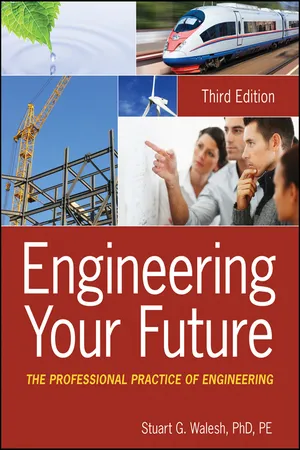Technology & Engineering
Types of Engineering
Engineering encompasses various specialized fields, including civil, mechanical, electrical, chemical, and aerospace engineering, among others. Each type of engineering focuses on specific applications and technologies, such as designing infrastructure, developing machinery, creating electrical systems, formulating chemical processes, and designing aircraft and spacecraft. These disciplines require unique skill sets and knowledge to address specific challenges and advance technology.
Written by Perlego with AI-assistance
Related key terms
5 Key excerpts on "Types of Engineering"
- eBook - ePub
- Graeme Dandy, David Walker, Trevor Daniell, Robert Warner, Graeme Dandy, Trevor Daniell, Bernadette Foley, Robert Warner(Authors)
- 2017(Publication Date)
- CRC Press(Publisher)
Subdivisions of the traditional fields, and the appearance of completely new engineering disciplines, have continued to this day. The newer engineering branches flourishing towards the end of the 20 th Century included aeronautical, aerospace, agricultural, automotive, biomedical, coastal, computer systems, electronic, environmental, mechatronic, medical, optical, rehabilitation, and transport engineering, to name but a few. The pace of engineering innovation and development has if anything accelerated into the 21 st Century, especially with the impetus from electronics, computer technology and information technology. Walesh (2012) has pointed out that 27 different types of undergraduate engineering programs were recognised in 2011 for the purpose of course accreditation in the United States by the organisation ABET (2011). With the relatively recent introduction of the Internet and with new developments in artificial intelligence, we can expect to see a rash of new innovative engineering applications in many fields in the near future. 1.3 THE NATURE AND SCOPE OF ENGINEERING WORK Although engineering work is becoming increasingly more diverse and more specialised, some characteristics are common, and this allows us to identify the basic nature of engineering work. A common characteristic is the need for engineering work to be undertaken in minimum time, and using limited resources such as people, energy, materials and money. For this reason, modern engineering work is undertaken as individual projects, with clearly specified goals. Another characteristic is the use of scientific knowledge, technology and mathematics. Activities that are common to the different fields and branches of engineering include planning and design, modelling and analysis, implementation, research and development, organizing and managing, and the sale and marketing of engineering products and services - eBook - ePub
- Carolina Machado, J. Paulo Davim(Authors)
- 2017(Publication Date)
- De Gruyter(Publisher)
All organizations need engineers from varied backgrounds with miscellaneous skills. Some types of engineers have deep, theoretical, scientific knowledge in many technical subjects in general, so they can be pioneers and leaders in many occupational fields and manage organizational structures. The second type of engineer focuses on a few subjects in detail, so they are occupational experts in their fields of interest. The remaining type, the third type, of engineer has direct practical experience in some application areas, such as in factory workshops and on job sites. All the different types of engineers have important contributions to make to the productivity of organizations.I would like to explain one particular provision by giving an unusual and impressive example to highlight the importance of engineers for all kinds of industrial, occupational, investigational, institutional, and academic areas, including medical applications, as described subsequently in Section 7.6.1.7.6.1A specific example of a medical technique in engineering and science
By giving a specific example in this section , it is possible to explain impressively and clearly the contribution and role of mechanical engineers, as well as engineers in other related engineering branches, to organizational management and productivity by emphasizing the level of their participation , even for a different and important science like medicine, and therefore for the importance of health of human beings and also for the sustainability of life. Moreover, there is a strong connection between these medical technique applications and the development of society and economic welfare.As an applied branch of engineering and science, medical technology has a broad range of uses. Medical devices, machines, equipment, and apparatus are widely used in medical diagnosis and treatment. Therefore, medical technology can be seen as an inseparable part of medical science.All over the world and also at the various space locations of the universe, changing from the robotic surgery to the space medicine, there are many fields of application of medical technology. This is an interdisciplinary technology and science, bringing together researchers, academics, engineers, and scientists from different fields of expertise, i.e., mainly mechanical engineering, electrical-electronics engineering, computer engineering, chemical engineering, engineering physics, astronomy, fundamental physics, fundamental chemistry, biology, mathematics, pharmacy, dentistry, and medicine itself. - eBook - ePub
Engineering
A Beginner's Guide
- Natasha McCarthy(Author)
- 2012(Publication Date)
- Oneworld Publications(Publisher)
2The world of the engineer and the engineering of the world
The history of engineering is a history of diversification and specialisation, as the creation of new technologies and the emergence of new skills and techniques spawns engineering sub-disciplines with expertise fit for the niches created. The evolution of engineering into diverse species began with the division of civil from military engineering, which was followed by the mechanical, electrical and other engineering groups distinguishing themselves from the kinds of projects engaged in by the original civil engineers. In addition, engineering specialisms were created by existing crafts and trades developing into engineering disciplines through the introduction of engineering method.This chapter will set out the ways in which engineering has changed the physical world. It will show what each engineering discipline involves by examining the impact that each has had on the world around us and the way that we live in it. But it should be recognised that each individual discipline of engineering can have only limited impact on its own. The lines between the specialisms are vague. Many engineers sit on the border of a variety of specialisms and most significant engineering projects are a collaboration between a number of disciplines. One of the essential skills of any breed of engineer is to be multidisciplinary, to be able to work with experts from other areas and to see where their work fits into the wider scheme. Engineers as a collective have changed the world, and no single discipline can claim to be the most influential.Civil engineering: the creation of cities and the taming of the countryAs the last chapter demonstrated, civil engineering is the oldest branch of the discipline that we think of as modern engineering. The ‘civil’ in civil engineering may initially have distinguished those engineers who worked on non-military projects from those that supported the work of soldiers at war, but it also connects intimately to the concept of civilisation. Living a healthy and safe life in large settlements and cities is made possible by civil engineering primarily through its management of water, the key element in supporting human life. Thus civil engineers plan, design and build the hidden labyrinth of pipework that allows the distribution of water to homes for drinking and washing but, perhaps more importantly, they construct the tunnels through which wastewater and sewage is flushed away. The management of clean and contaminated water makes life possible in large towns and cities, and without it we would be, and indeed once were, at risk of poisoning from our own waste. Civil engineers also protect us from the threats that water poses, by building flood defences and dams – allowing us to tame the forces of nature which formerly controlled the place of water in our life. - Julie Hallmark, Virginia Ann Baldwin(Authors)
- 2013(Publication Date)
- Routledge(Publisher)
Much of the research on the differences between engineers and scientists is dated and does not reflect the impact of changes in post-World War II engineering curricula. During World War II and throughout the era of Sputnik, government and industry leaders recognized that engineering training in the U.S. was not adequate to meet military and industrial challenges (Grayson, 1993). The Grinter Report, prepared by a committee of the American Society for Engineering Education (ASEE), urged the inclusion of more science and liberal arts into engineering education. This 1955 report transformed engineering education over the subsequent two decades from “hands-on” training to a more theoretical perspective resembling other types of academic disciplines, particularly the sciences. In his history of engineering education in the U.S., Grayson (1993) terms the period from World War II through 1970 the “scientific” period. Engineering education since the 1960s has tended to blur the distinction between the training of engineers and scientists. In addition, the types of work that they do in the large bureaucratic organizations that employ them makes it increasingly difficult to differentiate them by title alone. From a research perspective, it is difficult to observe a clear difference between engineers and scientists in many settings. Later in this article, we demonstrate the differences between engineers and scientists that are clearly reflected in their daily activities.Engineering is defined as the creation or improvement of technology. As such, it clearly encompasses both intellectual and physical tasks (i.e., both knowing and doing). Engineering work is fundamentally both a social and a technical activity. It is a social activity in that it often involves teamwork, as individuals are required to coordinate and integrate their work. It is also a social activity in that the production of the final product depends on the ability to maintain successful social relationships (e.g., negotiate with vendors, maintain smooth personal relations among members of a work group). Membership in a community is important for the effective functioning of current engineering and engineers. Engineers do their work in an embedded set of contextual relationships. Science, on the other hand, allows scientists to conduct their daily activities with only a vague reference to others doing similar work.Similarities
A number of writers note that engineers behave very similarly to scientists. At times, they adopt the methods used by scientists to generate knowledge. For example, according to Ritti (1971), engineering work consists of scientific experimentation, mathematical analysis, design and drafting, building and testing of prototypes, technical writing, marketing, and project management. Kemper (1990), too, noted that the typical engineer is likely to define problems, come up with new ideas, produce designs, solve problems, manage the work of others, produce reports, perform calculations, and conduct experiments. Florman (1987) described engineering work as encompassing both theory and empiricism. Ziman (1984) wrote that:Technological development itself has become “scientific.” It is no longer satisfactory, in the design of a new automobile, say, to rely on rule of thumb, cut and fit, or simple trial and error. Data are collected, phenomena are observed, hypotheses are proposed, and theories are tested in the true spirit of the hypothetico-deductive method, (p. 130)- eBook - ePub
Engineering Your Future
The Professional Practice of Engineering
- Stuart G. Walesh(Author)
- 2012(Publication Date)
- Wiley(Publisher)
The ultimate result of the design process – the fruit that grows from the root – is a useful structure, facility, system, product, or process. Aeronautical engineers design aircraft and spacecraft, civil engineers design high-speed rail systems, chemical engineers design processes to convert raw materials into finished products, and mechanical engineers design hybrid automobiles. As a result of their design orientation, all engineering disciplines deliver functional results some of which are stunning and widely acknowledged while others are unnoticed or taken for granted. Essentially all engineering designs contribute to the quality of life for untold users.Mathematics, natural sciences, humanities, and social sciences are the foundation of engineering, as explicitly described, for example, in the U.S. civil engineering body of knowledge (ASCE 2008). While being students and appreciators of that foundation, engineers go beyond, as a result of the design process, to develop plans for structures, facilities, systems, products, and processes useful to and sometimes aesthetically pleasing to society (Billington 1986). These plans are the root of the engineering process and the fruit is that which is ultimately constructed, manufactured, or otherwise implemented.Views of OthersTHIS CHAPTER’S APPROACH“Scientists define what is,” according to aeronautical engineer Theodore von Karman, “engineers create what never has been.” Civil engineering professor David P. Billington (1986) continues contrasting science and engineering as follows: “Science is discovery, engineering is design. Scientists study the natural, engineers create the artificial. Scientists create general theories out of observed data; engineers make things, often using only approximate theories.” And this final thought about design in the broad sense from engineer, industrialist, and philanthropist Eugene C. Grace: “Thousands of engineers can design bridges, calculate strains and stresses, and draw up specifications . . . , but the great engineer . . . can tell whether the bridge should be built, where it should be built, and when.”So how do we approach this vast, pan-engineering topic of design in one chapter? First, the treatment of design in this chapter is necessarily broad in scope; it is introductory. By the time a student uses this book in his or her formal education, he or she will have taken an in-depth design course in his or her chosen discipline, or will soon do so. Either way, for students, this chapter will provide context for future, current, or past design courses that have or will rely on books (e.g., Choi 2004, Ulrich and Eppinger 2008) and other resources that present discipline-specific descriptions of design. The young practitioner reader of this book will already have completed many design courses and hopefully have begun to experience design. For him or her, this chapter will also provide context as well as an opportunity to reflect, to revisit the all-important design function.
Learn about this page
Index pages curate the most relevant extracts from our library of academic textbooks. They’ve been created using an in-house natural language model (NLM), each adding context and meaning to key research topics.




